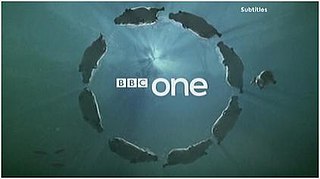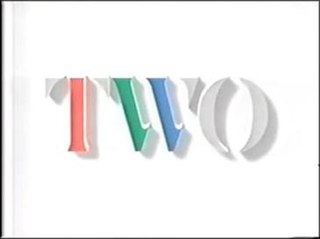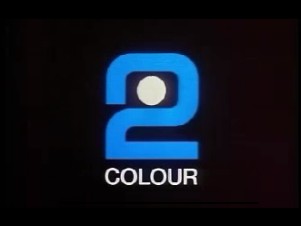BBC Prime was the BBC's general entertainment TV channel in Europe, Middle East, Africa, South Asia and Asia Pacific from 30 January 1995 until 11 November 2009, when it was replaced by BBC Entertainment.

Television presentation refers to the way in which television stations present themselves between programs.

The BBC One 'Rhythm & Movement' idents were a set of on-screen channel identities designed by Lambie-Nairn and used on BBC One from 29 March 2002 to 7 October 2006. They replaced the balloon idents, and spelled the end of the much recognised globe identity by the BBC, which had been used in various ways since 1963.

Noddy was a camera system used for generating idents for the BBC One and BBC Two television channels from late 1963 to February 1985.
The history of BBC television idents begins in the early 1950s, when the BBC first displayed a logo between programmes to identify its service. As new technology has become available, these devices have evolved from simple still black and white images to the sophisticated full colour short films seen today. With the arrival of digital services in the United Kingdom, and with them many more new channels, branding is perceived by broadcasters to be much more important, meaning that idents need to stand out from the competition.

Disney Channel was a British and Irish television kids channel owned and operated by The Walt Disney Company (UK) Ltd.

The Computer Originated World (COW) was the method of creating the BBC1 symbol that was used between 18 February 1985 and 16 February 1991. It was later used by the international, commercial television service BBC World Service Television from its launch until 26 January 1995.

The BBC One 'Circle' idents were a set of on-screen channel identities used on BBC One from 7 October 2006 to 4 December 2016. They also featured on the BBC Studios channel, BBC America. The idents contained images of circles being formed by nature, or people and their actions. This was the longest set of idents that was used by BBC One, as they lasted for 10 years.

The BBC Two '1991–2001' idents were broadcast from 16 February 1991 until 19 November 2001, and again from 9 July 2014 until 26 September 2018, on BBC Two in the United Kingdom. The idents, which consisted of a sans-serif '2' in Gill Sans, accompanied by the colour viridian, were created by branding agency Lambie-Nairn, who also created the Channel 4 logo.

The "Virtual Globe" was the method of creating the BBC1 symbol that was used between 16 February 1991 and 4 October 1997.

Martin John Lambie-Nairn was an English designer. He was the founder of his branding agency Lambie-Nairn and was the creative director of branding agency ML-N. He is recognised for having redefined television brand identity design, being the first to embrace computer technologies to apply branding to screen-based media.
The logo of the BBC has been a brand identity for the corporation and its work since the 1950s in a variety of designs. Until the introduction of a logo in 1958, the corporation had relied on its coat of arms for official documentation and correspondence, although this crest rarely appeared onscreen. With the increased role of television for the BBC in the 1960s, particularly after the foundation of ITV, the corporation used its logo to increase viewer familiarity and to standardise its image and content. The logo has since been redesigned a number of times, most recently in 2021 with the BBC blocks, a logo designed to work across media. From 1958, for this television network, there have been six different logos. The first logo of the network was used from 1958 to 1963, the second from 1963 to 1971, the third from 1971 to 1992, the fourth from 1988 to 1997, the fifth from 1997 to 2021, while the sixth and current logo was adopted in October 2021.

The BBC TwoPersonality idents were a set of idents used on BBC Two from 19 November 2001 until 18 February 2007. The idents were produced by the Lambie-Nairn branding agency, who had created the previous look. The idents feature an ivory sans serif white '2' in a yellow environment and performing a variety of tasks, and a purple boxed BBC Two logo.

The BBC Two 'Two' ident was the station identification used on BBC2 between 30 March 1986 and 16 February 1991. It was the last non-corporate look for the channel, and the only look until 2018 that did not feature a numeral '2' in the design.

The Cube 2 was an ident used by BBC Two between 2 December 1967 and 28 December 1974. It featured a stylised '2' that rotated on screen.

The Launch ident was a television station identification used by BBC Two between their launch night in 1964 and the introduction of colour in 1967.
Throughout the years, Children's BBC, and later CBBC and CBeebies, have used a number of different identities. The branding of the stranded service is distinctive both in the past and at present.
BBC Four, and its predecessor BBC Knowledge, are both channels operated by the BBC as cultural and knowledge based channels. Their visual identities therefore have been a result of this aim.
The presentation and the identities of the BBC News Channel, the international counterpart BBC World News and the BBC Parliament coverage channel use specific identities that demonstrate their remit and purpose.

HGTV is a British free-to-air television channel interior home and garden-orientated lifestyle television channel broadcasting in the United Kingdom and Ireland, currently owned by Warner Bros. Discovery. The channel originally launched on 1 November 1997 as UK Style and then was rebranded to Home on 30 April 2009 and was rebranded to its current form on 21 January 2020. HGTV is broadcast 24 hours a day on Sky and TVPlayer. UK Style was transmitted by terrestrial provider ITV Digital 24 hours a day until the company's collapse in 2002. After a slight rebrand to UKTV Style, the channel made a return to terrestrial screens for a time in the mid-2000s as part of the now-defunct Top Up TV system. Home became available as a free-to-air linear service on Freeview from 1 March 2016.














